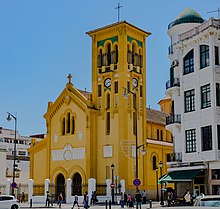History
Prior to independence, Morocco was home to half a million Europeans, [2] and European Christians formed almost half the population of the city of Casablanca. [3] Since the kingdom's independence in 1955, the European population has decreased substantially.
At the beginning of the 20th century, 250,000 Spaniards lived in Morocco. Most left Morocco after its independence and their numbers were reduced to 13,000. [4] [5] In 1950, Catholics in Spanish protectorate in Morocco and Tangier constitute 14.5% of the population, and the Spanish Morocco was home to 113,000 Catholic settlers. [6] Catholics in Spanish protectorate in Morocco and Tangier were mostly of Spanish descent, and to a lesser extent of Portuguese, French and Italian ancestry. [7]
During the French and Spanish protectorates, Morocco had significant populations of European Catholic settlers: on the eve of independence, an estimated 470,000 Catholics resided in Morocco. [1] Since independence in 1956, the European Catholic population has decreased substantially, and many Catholics left to France or Spain. Prior to independence, the European Catholic settlers had historic legacy and powerful presence. [1] Independence prompted a mass exodus of the European Catholic settlers; after series of events over 1959-1960 more than 75% of Catholic settlers left the country. [1]

Morocco, officially the Kingdom of Morocco, is a country in the Maghreb region of North Africa. It overlooks the Mediterranean Sea to the north and the Atlantic Ocean to the west, and has land borders with Algeria to the east, and the disputed territory of Western Sahara to the south. Morocco also claims the Spanish exclaves of Ceuta, Melilla and Peñón de Vélez de la Gomera, and several small Spanish-controlled islands off its coast. It spans an area of 446,300 km2 (172,300 sq mi) or 710,850 km2 (274,460 sq mi), with a population of roughly 37 million. Its official and predominant religion is Islam, and the official languages are Arabic and Berber; French and the Moroccan dialect of Arabic are also widely spoken. Moroccan identity and culture is a mix of Arab, Berber, African and European cultures. Its capital is Rabat, while its largest city is Casablanca.

Tangier is a city in northwestern Morocco, on the coasts of the Mediterranean Sea and the Atlantic Ocean. The city is the capital of the Tanger-Tetouan-Al Hoceima region, as well as the Tangier-Assilah Prefecture of Morocco.
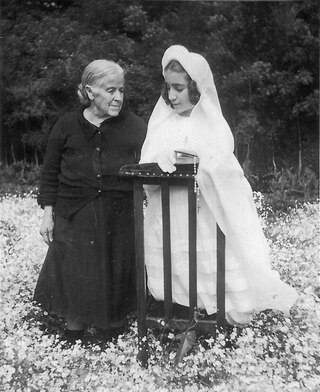
The pieds-noirs are people of French and other European descent who were born in Algeria during the period of French rule from 1830 to 1962; many of whom departed for mainland France once Algeria gained its independence.

Tétouan, also known as Tettawen, is a city in northern Morocco. It lies along the Martil Valley and is one of the two major ports of Morocco on the Mediterranean Sea, a few miles south of the Strait of Gibraltar, and about 60 kilometres (37 mi) E.S.E. of Tangier. In the 2014 Moroccan census, the city recorded a population of 380,787 inhabitants. It is part of the administrative division Tanger-Tetouan-Al Hoceima.

The French protectorate in Morocco, also known as French Morocco, was the period of French colonial rule in Morocco between 1912 and 1956. The protectorate was officially established 30 March 1912, when Sultan Abd al-Hafid signed the Treaty of Fez, though the French military occupation of Morocco had begun with the invasion of Oujda and the bombardment of Casablanca in 1907.

The Spanish protectorate in Morocco was established on 27 November 1912 by a treaty between France and Spain that converted the Spanish sphere of influence in Morocco into a formal protectorate.

The Republic of the Rif was a confederate republic in the Rif, Morocco, that existed between 1921 and 1926. It was created in September 1921, when a coalition of Rifians led by Abd el-Krim revolted in the Rif War against the Spanish protectorate in Morocco under the Alaouite dynasty. The French would intervene on the side of Spain in the later stages of the conflict. The Republic was the first independent nation-state Republic in the history of Africa. A protracted struggle for independence killed many Rifians and Spanish–French soldiers, and witnessed the use of chemical weapons by the Spanish army—their first widespread deployment since the end of the World War I. The eventual Spanish–French victory was owed to the technological and manpower advantages enjoyed by the colonizers, in spite of their lack of morale and coherence. Following the war's end, the Republic was ultimately dissolved in 1926.

Moroccan Jews constitute an ancient community. Before the founding of the State of Israel in 1948, there were about 265,000 Jews in the country, which gave Morocco the largest Jewish community in the Muslim world, but by 2017 only 2,000 or so remain. Jews in Morocco, originally speakers of Berber languages, Judeo-Moroccan Arabic or Judaeo-Spanish, were the first in the country to adopt the French language in the mid-19th century, and unlike the Muslim population French remains the main language of members of the Jewish community there.

The Catholic Church in Algeria is part of the worldwide Catholic Church, under the spiritual leadership of the Pope in Rome.
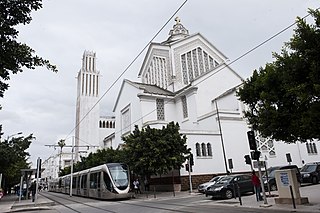
The Catholic Church in Morocco is part of the worldwide Catholic Church, under the spiritual leadership of the Pope in Rome. Catholics account less than 1% of the overall population of over 31 million. The country is divided into two archdioceses; Rabat and Tangier.
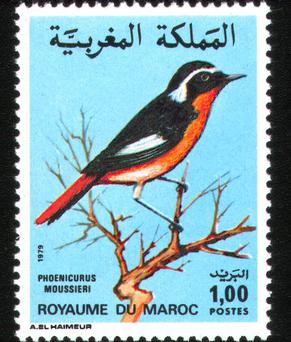
The postal history of Morocco is complex due to the country's political development in the 20th century. Mail was sent via post offices operated by the Sherifian post created by the Sultan, and by the European powers. After Morocco was partitioned into protectorates of France and of Spain in 1912, both European administrations established postal services in their respective zones.

Christians in Morocco constitute less than 1% of the country's population of 33,600,000. Most of the Christian adherents are Catholic and Protestants.

The history of immigration to the United States details the movement of people to the United States from the colonial era to the present. Throughout U.S. history, the country experienced successive waves of immigration, particularly from Europe and later from Asia and Latin America. Colonial-era immigrants often repaid the cost of transoceanic transportation by becoming indentured servants in which the new employer paid the ship's captain. In the late 19th century, immigration became restricted from China and Japan. In the 1920s, restrictive immigration quotas were imposed although political refugees had special status. Numerical restrictions ended in 1965. In recent years, the largest numbers have come from Asia and Central America.
White Africans of European ancestry refers to people in Africa who can trace full or partial ancestry to Europe. In 1989, there were an estimated 4.6 million white people with European ancestry on the African continent.
The main religion in Morocco is Sunni Islam, which is also the state religion of the country.Officially, 99% of the population are Muslim, and virtually all of those are Sunni. The second-largest religion in the country is Christianity, but most Christians in Morocco are foreigners. There is a community of the Baháʼí Faith. Only a fraction of the former number of Maghrebi Jews have remained in the country, many having moved to Israel.

The Tangier International Zone was a 382 km2 (147 sq mi) international zone centered on the city of Tangier, Morocco, which existed from 1925 until its reintegration into independent Morocco in 1956, with interruption during the Spanish occupation of Tangier (1940–1945), and special economic status extended until early 1960. Surrounded on the land side by the Spanish protectorate in Morocco, it was governed under a unique and complex system that involved various European nations, the United States, and the Sultan of Morocco, himself under a French protectorate.

European Tunisians are Tunisians whose ancestry lies within the ethnic groups of Europe, notably the French and Italian. Other communities include those from Southern Europe and Northwestern Europe.
The official language of Illinois is English. Nearly 80% of the population speak English natively, and most others speak it fluently as a second language. The forms of American English spoken in Illinois range from Inland Northern near Chicago and the northern part of the state, to Midland and Southern dialects further downstate. Illinois has speakers of many other languages, of which Spanish is by far the most widespread. Illinois's indigenous languages disappeared when the Indian population was deported under the policy of Indian Removal.
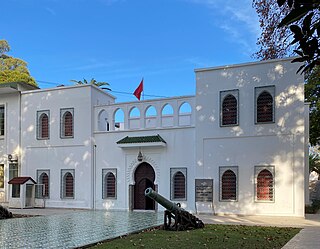
The Mendoubia or Mandubiyya refers to the former ceremonial mansion of the Mendoub, the representative of the Sultan of Morocco in the Tangier International Zone from 1924 to 1956. It now houses the commercial court of Tangier and a memorial museum.
The Moroccan seizure of the Betsey was an incident in which Moroccan naval forces captured the Philadelphia merchant ship Betsey on October 11, 1784. After delays by the United States government to sign a treaty, the Sultan of Morocco Mohammed bin Abdallah ordered the capture of the ship. The ship and crew were taken hostage in Tangier until July 9, 1785.
